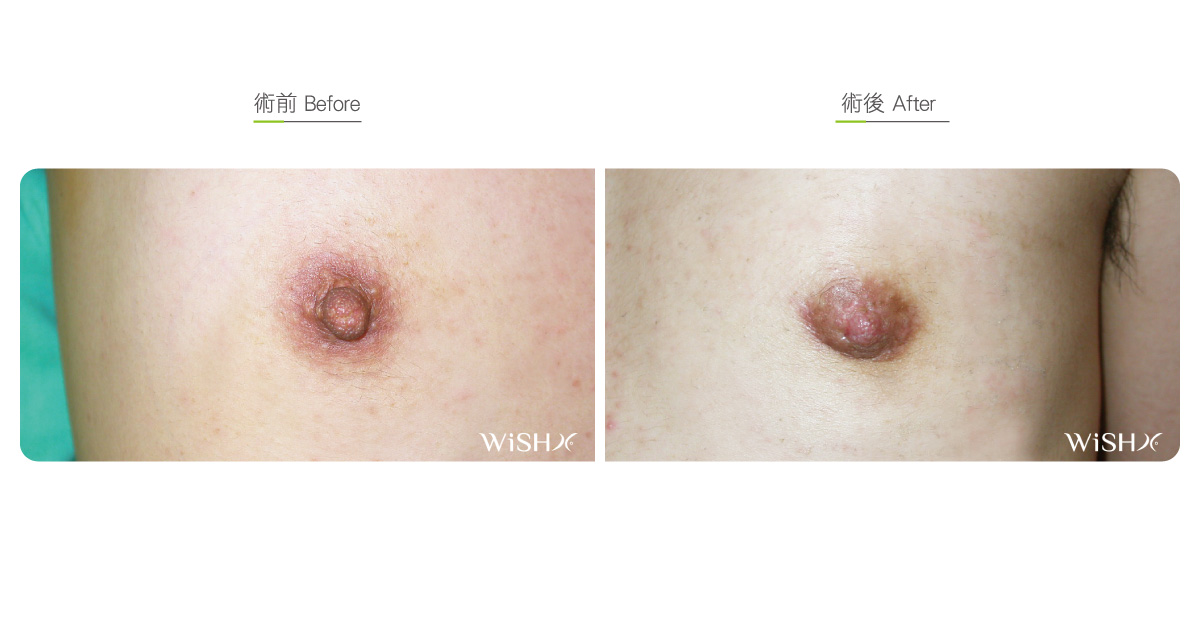Nipple Reduction
Common female nipple reduction only needs to reduce the nipple within a reasonable proportion (the nipple accounts for one-third of the areola in diameter), but due to the necessity of concurrent reduction of the areola, female-to-male patients have to undergo resection of more nipple tissues to achieve ultimate nipple shrinkage and shortening. The surgical method is determined in line with the individual congenital hypertrophy degree of papillary tissues, but a majority of patients need to undergo both nipple size reduction and height shortening, including the resection of skin at the base of the nipple, reduction in the nipple height, and resection of the lateral nipple parts (nipple sagittal wedge resection) to decrease the frontal size. The maximal reduction is up to two-thirds of the original nipple, namely preservation of only one-third of the nipple tissues, to sculpt masculine nipples. The advantages are the preservation of regional nipple sensitivity after the operation and less visible scars, but the disadvantages are the difficulty in restoring the original nipple appearance and probability of nipple blood circulation disturbance or necrosis in case of excess resection. In addition, for some female patients with overtly hypertrophic or hyperplasic nipples, the extreme frontal nipple wedge-shaped resection is adopted to resect a larger part of the nipples from the top to the bottom. The advantage is that the nipples are reduced to a higher degree than that by sagittal resection, thus reducing the nipples to an almost masculine appearance. The disadvantages are visible scars, probable loss of nipple sensitivity, and nipple necrosis due to regional blood circulation disruption.

Illustration of nipple reduction
Surgical conditions
Duration
- Type of anesthesia: IV sedation + local anesthesia
- Type of incision: Peripheral or frontal incision at the nipple
- Recovery: 2–3 days
- Removal of stitches: 7–10 days
General instructions
No food and water on the day of surgery
Preoperative:
- Do not smoke for at least 1 week preoperatively.
Postoperative:
- Do not consume alcohol or smoke for 3 months postoperatively.
- Do not frequently stimulate the nipple in the future in case of tissue proliferation or secondary hypertrophy.
Ideal candidates
- Patients who want to change their female nipples to male nipples
- Those who want to radically resolve their overtly projected nipples
- Those who want to maximally reduce their nipples
Possible complications
- Scar
- Nipple atrophy
- Necrosis
- Decreased or no sensitivity
Surgical advantages
-
It is able to obliterate feminine breast characteristics to satisfy the needs of patients for masculine nipples.
-
It is able to permanently get rid of the disturbances of exceedingly projected nipples.
-
It is able to make the male breasts and nipples proportionate after breast reduction.
Surgical drawbacks
-
Nipple sensitivity may be decreased or deprived.
-
Excess resection of the nipple tissues may disrupt blood circulation, thus resulting in necrosis or atrophy.
-
The original nipple appearance cannot be restored in the future.
-
Breastfeeding is not possible in the future.

